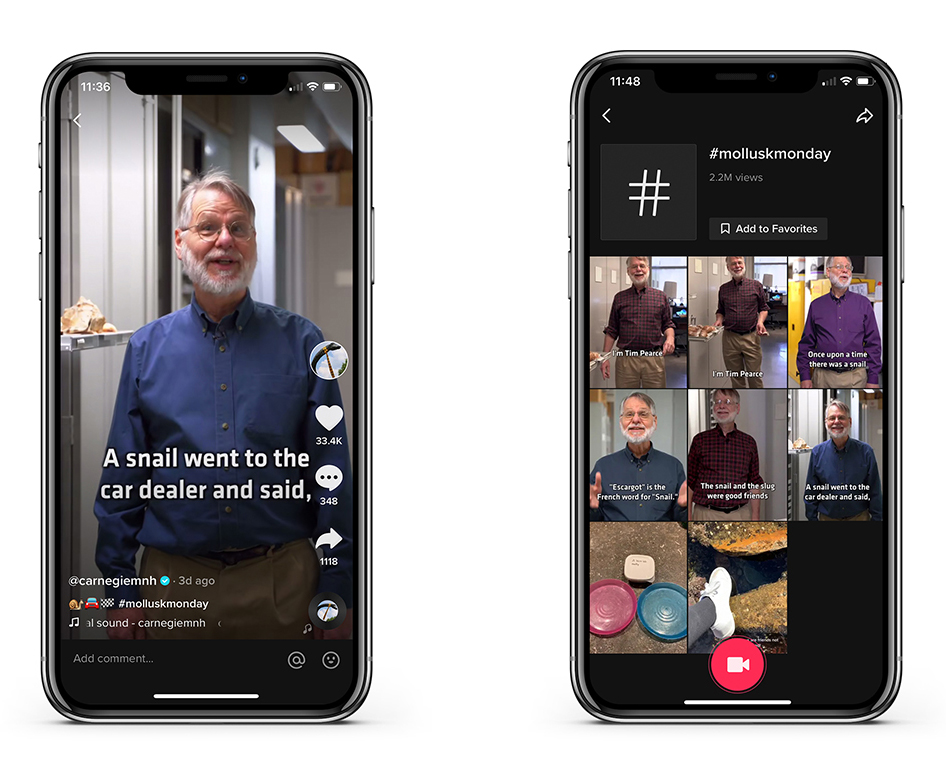On the surface, Vancouver’s destination marketing organization has little in common with a science museum in Pittsburgh. But over the past nine months both Tourism Vancouver and Carnegie Museum of Natural History (CMNH) have grown audiences by creating short-video content for Douyin and TikTok respectively.
Best known as buzzy repositories for teenage memes and dance routines, the breakneck growth of the apps, both owned by Chinese tech giant ByteDance, has been striking; Douyin has 400 million daily users and its western counterpart sees users spending 38 minutes glued to its endless scroll. Fear of missing out has long been a catalyst for social media, not forgetting the addictive algorithms, but the impetus for cultural institution to launch on yet another social media platform may not initially be clear.
Jing Travel spoke to both Tourism Vancouver and CMNH to learn why they launched and how they create compelling content 15 seconds at a time.
Snail Jokes and Trending Hashtags
CMNH unabashedly identifies as a ‘lighthearted nerd’ and a swift scroll through the museum’s TikTok account confirms the notion. Open a random video and you’ll likely find the museum’s head of mollusks in chinos and a button-down shirt (tucked in, naturally) telling a snail joke. In a world where social media campaigns are often driven by marketing acronyms, CMNH’s snail jokes might seem low-key and unstructured. But that’s precisely why they’ve proven successful, to the order of 1.6 million views in the case of Tim Pearce’s M(shell) Obama joke.
“When we started learning about TikTok, we thought the jokes would be a perfect fit; unique and fun but also on brand for the museum,” says Sloan MacRae, Director of Visitor Services at the museum, “[the videos] have a calming positive energy that can be difficult to find in the current social media landscape.”
When a museum of natural history goes viral on any platform there’s a certain element of chance involved, but CMNH raised the odds by engaging their young, phone-hugging, audience on the current app of choice—49 percent of U.S. teenagers have downloaded TikTok.

Pittsburg’s CMNH has a collection of more than 22 million specimens. Image: CMNH TikTok, Peter Huang.
Achieving TikTok traction typically requires a hashtag for users to follow and respond to. CMNH created #molluskmondays, which, to date, has 2.2 million views. The formula is simple, every Monday the museum posts Tim Pearce’s latest snail joke complete with emojis, cutesy stickers, and humorous voice effects. The result is an authentic depiction of CMNH’s character delivered in the audio-visual language of TikTok’s user base.
“Commenters often say Tim Pearce has “Bob Ross vibes” or that he reminds them of Mister Rogers, both of whom were earnest and had a calming, positive energy,” says MacRae who goes on to note the difficulty of correlating social media campaigns to museum attendance.
Instead, CMNH focuses on reaching as many science lovers as possible, irrespective of what comes next, “we want to make science accessible. We hope our TikTok videos spark curiosity about the museum in our viewers.”
High-Quality Video and Chinese Celebrities
In contrast, Tourism Vancouver’s Douyin campaign is more directly focused on increasing visitation. The DMO’s Douyin campaigns may not have reached viral status, but its series of short-videos depicting the Western Canadian city through the eyes of Chinese celebrities earned it more than 50,000 followers.
Douyin users skew slightly older than TikTok with 43 percent concentrated in Tier 1 and Tier 2 cities (Chinese cities are unofficially organized by a hierarchy of population and importance). Given Vancouver’s target Chinese audiences are broadly free independent travelers, young couples, and young families, Douyin is an ideal platform for DMOs to reach outbound post-80s and post-90s travelers.
“Every platform has its own demographic. According to Douyin, most users are well-educated and affluent which are in line with our target market in China,” says Stephen Pearce, VP Strategy and International Markets, “Douyin allows us to reach a younger demographic with the type and style of video content they are looking for.”
Created by an in-house Chinese team and a creative agency, Tourism Vancouver’s Douyin videos are a far cry from CMNH’s quirky, homespun uploads. With high-quality camerawork, slick-editing, and upbeat backing music, the videos celebrate aspects of city life that appeal to its target audiences. Vancouver’s culinary scene is shown through kitchen-side conversations with chefs, outdoor sports through skeleton runs down the 2010 Olympic track, and entertainment through a family outing to a Vancouver Canucks game.

Tourism Vancouver’s Douyin campaigns connect the city’s more than 500,000 Chinese heritage residents. Image: Tourism Vancouver Douyin, Peter Huang.
Its most successful campaign featured Zhao Lei, a celebrated young folk singer with more than 100,000 followers on Weibo, a Chinese microblogging site. The series of four videos traced Zhao’s visit to Vancouver from his arrival at the airport, through conversations with local artists, along Capilano Suspension Bridge, and culminated with filming his music video for “Song of the 80s” in the pristine forests that surround the city.
“Zhao Lei’s folk style is very down-to-earth and his music is engaging to Chinese people from all walks of life,” says Pearce, “We aim to create content purpose-made for China, and emphasize cultural relevance instead of direct English-Chinese translation to create a deeper engagement.”
The style and quality of the videos may outdo the efforts of the average Chinese tourist, but Zhao’s Douyin videos capture snippets of the Vancouver experience in the right visual language.
Conclusions
When it comes to launching on TikTok or Douyin, institutional hesitation is understandable given our saturated social media landscape. Yet, as CMNH and Tourism Vancouver are demonstrating, success can be achieved provided you understand both the audience and medium at hand.
Content repurposed from other platforms doesn’t work, instead, focus on capturing your organization’s unique character in 15 second snapshots. Embrace the visual language your target audience uses and include thematic hashtags to encourage audience conversation. Oh, and a friendly (or famous) face helps too!
Edited by Peter Huang.



